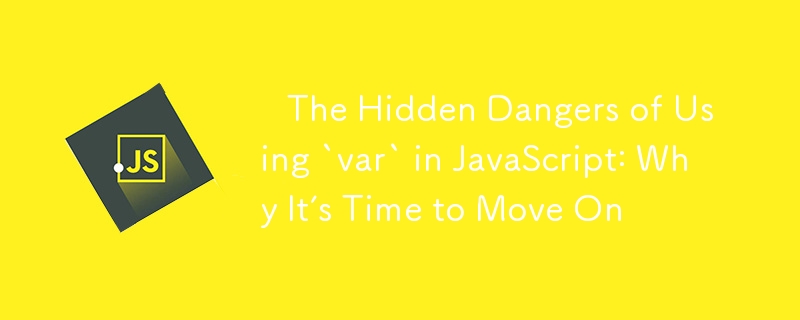
关键字 var 多年来一直是 JavaScript 中声明变量的默认方式。但是,它有一些怪癖和陷阱,可能会导致代码出现意外行为。现代替代方案(如 let 和 const)解决了许多此类问题,使它们成为大多数情况下声明变量的首选。
?说明:
在 JavaScript 中,var 声明被提升到其作用域的顶部,这意味着即使声明稍后出现在代码中,它们也会被初始化为未定义。这可能会导致令人困惑的行为并导致难以检测的错误。
?要点:
?示例:
console.log(myVar); // undefined (hoisted but not initialized) var myVar = 10; console.log(myVar); // 10
?注释: 变量 myVar 被提升到作用域的顶部,但最初是未定义的,这可能会导致代码混乱。
?修复:
?修复示例:
console.log(myLet); // ReferenceError: myLet is not defined let myLet = 10; console.log(myLet); // 10
?注释: 使用 let 可以防止变量在声明之前被访问,从而减少混乱和潜在的错误。
?说明:
var 的主要缺陷之一是它是函数作用域,而不是块作用域。这意味着在循环、if 语句或其他块内声明的变量不限于该块,而是可以在其外部访问,这可能会导致错误。
?要点:
?示例:
if (true) {
var blockVar = "I’m accessible outside this block";
}
console.log(blockVar); // "I’m accessible outside this block"
?注释: 虽然 blockVar 是在 if 块内声明的,但它仍然可以在块外访问,因为 var 是函数作用域,而不是块作用域。
?修复:
?修复示例:
if (true) {
let blockLet = "I’m only accessible inside this block";
}
console.log(blockLet); // ReferenceError: blockLet is not defined
?注释: 使用 let 或 const 可确保变量保持在各自的块内,防止作用域泄漏。
?说明:
使用 var,您可能会意外地在同一作用域中重新声明同一变量,这可能会覆盖以前的值。这可能会导致无意的错误,尤其是在较大的代码库中,变量名称可能会被错误地重用。
?要点:
?示例:
var name = "Alice"; var name = "Bob"; // No error, overwrites the previous value console.log(name); // "Bob"
?评论: 第二个名称声明会覆盖第一个名称,可能会导致代码中出现错误。
?修复:
?修复示例:
let name = "Alice"; let name = "Bob"; // SyntaxError: Identifier 'name' has already been declared
?评论: 使用 let 或 const 可以帮助您避免重新声明变量并确保您的代码保持可预测性。
?说明:
在循环中使用 var 时,变量的值可能会以意想不到的方式更改,尤其是在使用异步代码时。由于 var 是函数作用域而不是块作用域,因此在异步回调内访问时,循环变量可能会包含意外值。
?要点:
? Example:
for (var i = 0; i < 3; i++) {
setTimeout(() => console.log(i), 1000); // Prints: 3, 3, 3 (unexpected)
}
? Comment: Because var is not block-scoped, the loop variable i is shared across all iterations, and its final value (3) is used in each setTimeout callback.
? Fix:
? Example Fix:
for (let i = 0; i < 3; i++) {
setTimeout(() => console.log(i), 1000); // Prints: 0, 1, 2 (as expected)
}
? Comment: Using let creates a new instance of i for each iteration, fixing the asynchronous callback issue and ensuring the correct values are printed.
? Explanation:
Closures can lead to unexpected behavior when combined with var. Since var is function-scoped, its value might change in ways that are not expected when a closure captures it.
? Key Points:
? Example:
function createFunctions() {
var funcs = [];
for (var i = 0; i < 3; i++) {
funcs.push(function() {
console.log(i);
});
}
return funcs;
}
var myFuncs = createFunctions();
myFuncs[0](); // 3 (unexpected)
myFuncs[1](); // 3 (unexpected)
myFuncs[2](); // 3 (unexpected)
? Comment: All closures are capturing the same i value because var is function-scoped, leading to unexpected results.
? Fix:
? Example Fix:
function createFunctions() {
var funcs = [];
for (let i = 0; i < 3; i++) {
funcs.push(function() {
console.log(i);
});
}
return funcs;
}
var myFuncs = createFunctions();
myFuncs[0](); // 0
myFuncs[1](); // 1
myFuncs[2](); // 2
? Comment: With let, each closure gets its own copy of i, fixing the issue and ensuring the expected values are printed.
While var was the original way to declare variables in JavaScript, it has several shortcomings that make it a poor choice in modern JavaScript development. The introduction of let and const provides better scoping, reduces the risk of bugs, and makes your code more predictable. To write cleaner and more maintainable JavaScript, it's time to move on from var and embrace let and const.
以上是⚠️ 在 JavaScript 中使用 `var` 的隐藏危险:为什么是时候继续前进了的详细内容。更多信息请关注PHP中文网其他相关文章!




